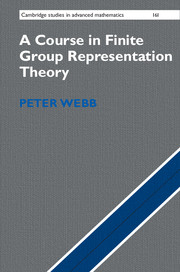Book contents
- Frontmatter
- Contents
- Preface
- 1 Representations, Maschke's Theorem, and Semisimplicity
- 2 The Structure of Algebras for Which Every Module Is Semisimple 15
- 3 Characters
- 4 The Construction of Modules and Characters
- 5 More on Induction and Restriction: Theorems of Mackey and Clifford
- 6 Representations of p-Groups in Characteristic p and the Radical
- 7 Projective Modules for Finite-Dimensional Algebras
- 8 Projective Modules for Group Algebras
- 9 Changing the Ground Ring: Splitting Fields and the Decomposition Map
- 10 Brauer Characters
- 11 Indecomposable Modules
- 12 Blocks
- Appendix A Discrete Valuation Rings
- Appendix B Character Tables
- Bibliography
- Index
7 - Projective Modules for Finite-Dimensional Algebras
Published online by Cambridge University Press: 05 August 2016
- Frontmatter
- Contents
- Preface
- 1 Representations, Maschke's Theorem, and Semisimplicity
- 2 The Structure of Algebras for Which Every Module Is Semisimple 15
- 3 Characters
- 4 The Construction of Modules and Characters
- 5 More on Induction and Restriction: Theorems of Mackey and Clifford
- 6 Representations of p-Groups in Characteristic p and the Radical
- 7 Projective Modules for Finite-Dimensional Algebras
- 8 Projective Modules for Group Algebras
- 9 Changing the Ground Ring: Splitting Fields and the Decomposition Map
- 10 Brauer Characters
- 11 Indecomposable Modules
- 12 Blocks
- Appendix A Discrete Valuation Rings
- Appendix B Character Tables
- Bibliography
- Index
Summary
In previous sections, we have seen the start of techniques to describe modules that are not semisimple. The most basic decomposition of such a module is one that expresses it as a direct sum of modules that cannot be decomposed as a direct sum any further. These summands are called indecomposable modules. We have also examined the notions of radical series and socle series of a module, which are series of canonically defined submodules that may shed light on submodule structure. We combine these two notions in the study of projective modules for group rings, working at first in the generality of modules for finitedimensional algebras over a field. In this situation the indecomposable projective modules are the indecomposable summands of the regular representation. We will see that they are identified by the structure of their radical quotient. The projective modules are important because their structure is part of the structure of the regular representation. Since every module is a homomorphic image of a direct sum of copies of the regular representation, by knowing the structure of the projectives we gain some insight into the structure of all modules.
Characterizations of Projective and Injective Modules
Recall that a module M over a ring A is said to be free if it has a basis; that is, a subset ﹛xi |i ∈ I﹜ that spans M as an A-module, and is linearly independent over A. To say that ﹛xi |i ∈ I﹜ is a basis of M is equivalent to requiring M = ⴲi∈IAxi with A ≅ Axi via an isomorphism a ⟼ axi for all i. ThusM is a finitely generated free module if and only if M ≅ An for some n. These conditions are also equivalent to the condition in the following proposition:
Proposition 7.1.1.Let A be a ring and M an A-module. The following are equivalent for a subset ﹛xi |i ∈ I﹜ of M:
(1) ﹛xi |i ∈ I﹜ is a basis of M,
(2) for everymodule N and mapping of sets ϕ : ﹛xi |i ∈ I﹜ → N there exists a unique module homomorphism ψ : M → N that extends ϕ.
- Type
- Chapter
- Information
- A Course in Finite Group Representation Theory , pp. 115 - 134Publisher: Cambridge University PressPrint publication year: 2016



